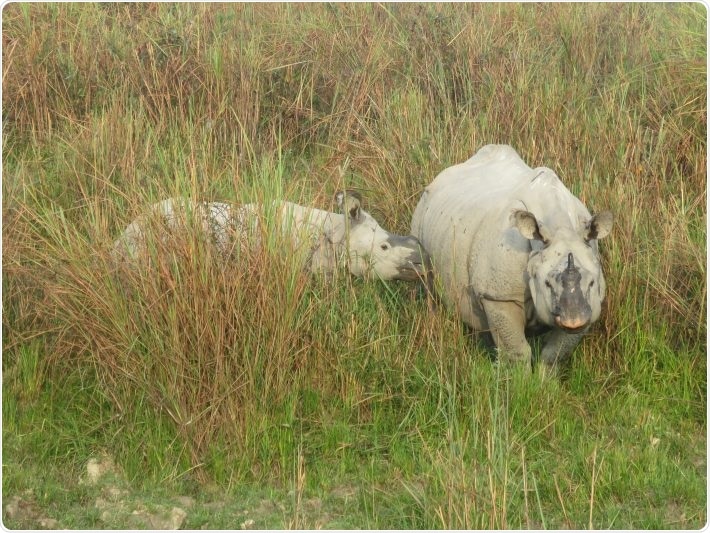For the first time, scientists from the Wildlife Institute of India (WII) have applied exclusive DNA markers to offer forensic proof for suspected poaching cases that involved the Indian rhino.

Adult greater one-horned rhinoceros, Rhinoceros unicornis, and her calf. Image Credit: Tista Ghosh.
The new study is part of the Rhino DNA Indexing System (RhODIS- India) conservation program. Scientists created this database to develop a DNA catalog of the existing Rhinoceros unicornis—the Indian greater one-horned rhinoceros—to address rhino poaching and support conservation efforts toward this helpless species.
Motivated by an analogous program in South Africa, Tista Ghosh, a Ph.D. student, and senior research fellow, together with Dr. Samrat Mondol (WII) and Amit Sharma (WWF India), obtained dung from a total of 749 rhinoceros to collect significant genetic data.
The team examined dung to detect signs of population-specific genetic signals and eventually created a genetic baseline for rhinoceros throughout India. This allowed them to identify 406 unique individual rhinos.
Nuclear DNA contains microsatellite markers, analogous to a fingerprint, where every individual has its own exclusive genetic signature. Scientists use 14 markers to detect individual rhinos from dung data based on the special signature of individual rhinos.
When the researchers compared samples of the seized rhino horns to these particular genetic signals, they were able to trace the rhino back to its breeding population. This allowed them to identify and pinpoint poaching hotspots, which are very difficult to track by conventional law enforcement.
Having an allele frequency map aids in pinpointing the location of the orphan seized rhino sample to its breeding population based on genetic signatures.”
Tista Ghosh, PhD Student and Senior Research Fellow, Wildlife Institute of India
Besides this, the WII forensics team successfully matched a suspected poached carcass from a protected area to a seized horn, which was identified elsewhere along India’s trade route. At times, the team had to work with just blood-stained soil, a bullet, or pebbles to carry out DNA profiling.
Such results demonstrate the robust abilities of this microsatellite panel and display their means of dealing with wildlife crime and offering useful insights to the forest department. Individual DNA matching offers solid scientific proof with respect to the poaching of wild rhino—a native to India—and thus assists in court prosecutions.
Concerning the importance of this method, Tista added, “Many times the seized rhino body parts are found after a long time of poaching incidences as a result of which it becomes difficult to pinpoint the location of the crime. Thus, it is important to locate such networks and have law enforcement resulting in breaking the chain of trading.”
In India, the present population of greater one-horned rhinoceros is comparatively small, at around 3,500 individual rhinos. The researchers used statistical probabilities and estimated that 14 microsatellite markers were more than enough to perform individual matching across the entire range of the population.
Furthermore, the team is looking forward to partner with Nepal field teams to expand this study to the second stronghold of greater one-horned rhinoceros species.
But in the domain of wildlife forensics, major limitations exist because of the substandard quality of samples, and scenarios when information could not be created using only the microsatellite.
According to Tista, in those circumstances of interesting developments, “We are planning to do a mitochondrial DNA screening to look for park/state-specific genetic markers and combine that data with our existing database to avoid such situations.”
Moreover, the RhODIS-India marker panel is designing an “allelic ladder” (reference point) to make comparisons with other labs. As soon as it becomes available, this will promote more associations between the wildlife forensics community around the world.
To boost the size of the database, strategies are already in place to perform broader sampling across the range of Indian rhinos.